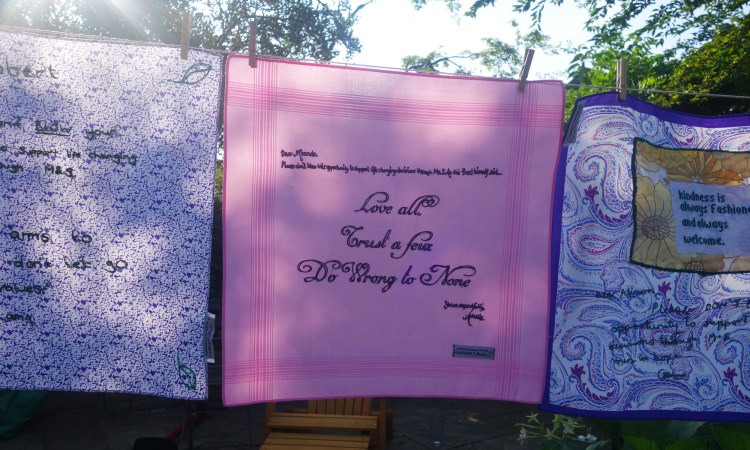
Effective activism isn’t just picketing, petitions and marches; it also includes actions that are as subtle as sewing. Craftivist Sarah Corbett takes us through her engaging and empathetic campaign to persuade Marks & Spencer to pay employees a Living Wage.
Marks & Spencer, one of the largest retail companies in the UK, wouldn’t budge. For three years, the UK-based nonprofit ShareAction had asked it to become a “Living Wage” employer. Living Wage is an hourly salary that is substantial enough for someone to live with dignity and support a family. Currently, it is £10.55 in London and £9 in the rest of the UK (these figures are as of November 2018; it’s adjusted annually to account for cost of living changes).
Nearly 3,000 employers in the UK — big names such as Nestlé, ITV, SSE, Pearson, GSK and Burberry — had already become accredited as Living Wage employers, including nearly one-third of the FTSE 100, the largest publicly-listed companies in the UK. But as of 2015, no high-street retailer had signed up.
Marks & Spencer (M&S) is a national institution, and most people grew up with it in their lives. ShareAction wanted the department-store chain, which employs 80,000 people, to commit to a living wage. If it did, it could have ripple effects through the retail sector. But the then-CEO refused.
In May 2015, I received a message from Catherine Howarth, the CEO of ShareAction. She’d read my book A Little Book of Craftivism and wanted my help. I was given five weeks to plan and deliver a campaign before the M&S 2015 annual general meeting (AGM) in July, and my goal was to secure a future sit-down meeting between the company and ShareAction to discuss the possibilities of becoming a Living Wage Employer.
Since the CEO opposed such a meeting, I decided to focus on engaging the 14 board members who’d be attending the AGM. Previously, I’d sent a handkerchief with a personally embroidered message to my Member in Parliament, and it helped us form a respectful relationship. I decided to build on that idea.
I also added the five Chief Investment Officers of the five largest investing companies to our list of recipients. If they supported the Living Wage campaign, the company would find them difficult to ignore. Finally, we targeted five celebrities who modeled for the company’s recent ad campaign, as their involvement could help us gain media attention.
I bought 24 handkerchiefs at M&S to show that we were not boycotting them, and in the UK’s Craftivist Collective, I recruited 24 craftivists, male and female, who were also loyal M&S customers. Many of them were quiet people, which would serve to strengthen our efforts. I didn’t want to risk anyone being obnoxious at the AGM or indulging in negative campaigning. I wanted the board members to see that we were concerned customers who also happened to be activists. We wanted to encourage them to do the best job they could in their roles — not bully them into an action.
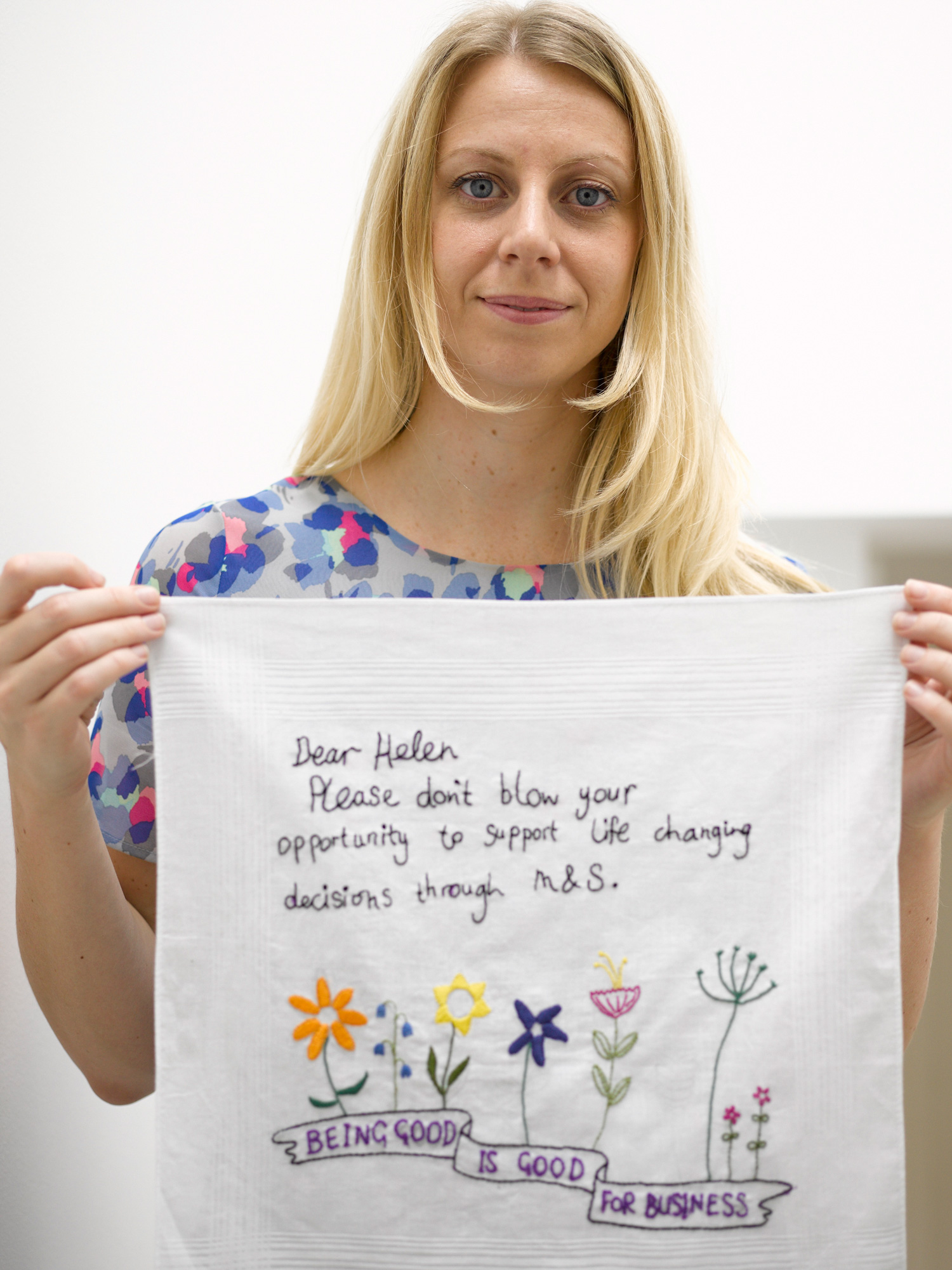
I matched the 24 craftivists with the 24 hanky-receivers, considering shared interests or similarities. For example, I paired a craftivist who had just become a new mum with a board member who has small children. I mailed the hankies out to the craftivists, and I included “crafterthought” questions for them to reflect on while they stitched. These included “What challenges do you think your designated hanky-receiver would face trying to implement the living wage?” and “How would you feel if you were a staff member working full time for this company but couldn’t afford to pay for basic necessities to live comfortably?” These queries were to help the craftivists engage in the issue more deeply, critically and compassionately and inspire them to make empathetic gifts, which, in turn, would make their gifts more impactful.
I asked each craftivist to research their board member to help them create the most emotionally engaging gift possible. The message on the hanky needed to be just as beautiful, thoughtful and graceful as its design. I gave the craftivists the below template but encouraged them to tweak it. I suggested they stitch part of the message in their own handwriting but gave them creative control over the rest of the layout.
The template message was:
Dear [full name of board member],
Please don’t blow your opportunity to support life-changing decisions through Marks & Spencer … [an inspiring quote the hanky-receiver could relate to, stitched in a bigger, prettier font with any other embellishments they wanted to make like images/symbols etc.]
Yours sincerely [the maker’s name]
I provided participants with sample quotes to give them an idea of tone, length and style to aim for, but they were free to choose their own quotations. Craftivist Caroline said, “My recipient is Sikh, and so I found a quote with the help of my Sikh friend — ‘By the karma of good actions, some come to serve the Perfect Guru’ by Sri Guru Granth Sahib Ji — for my hanky. I want to inspire him to understand that the true quality of a retail brand will be shown by how they treat all their staff.”
Craftivist Gemma made a hanky with the message: “Kindness is always fashionable and always welcome.” The words were cross-stitched on a patch of fabric from a piece of clothing that her grandmother had bought from M&S decades ago. One of the board members was the trustee of a national garden, so his craftivist stitched flowers on his hanky. Since another was on the board of an opera company, his hanky had musical notes and a quote from a musician.
Each of the 24 hankies were completely different, but they were all positive, encouraging and beautiful. To explain them and to add a strong argument for why paying the Living Wage was good for business and employees, the craftivists wrote letters to be enclosed with their hankies (along with an info sheet on the Living Wage). Each hanky was placed in a gift box wrapped in colored ribbon and a personalized name tag.
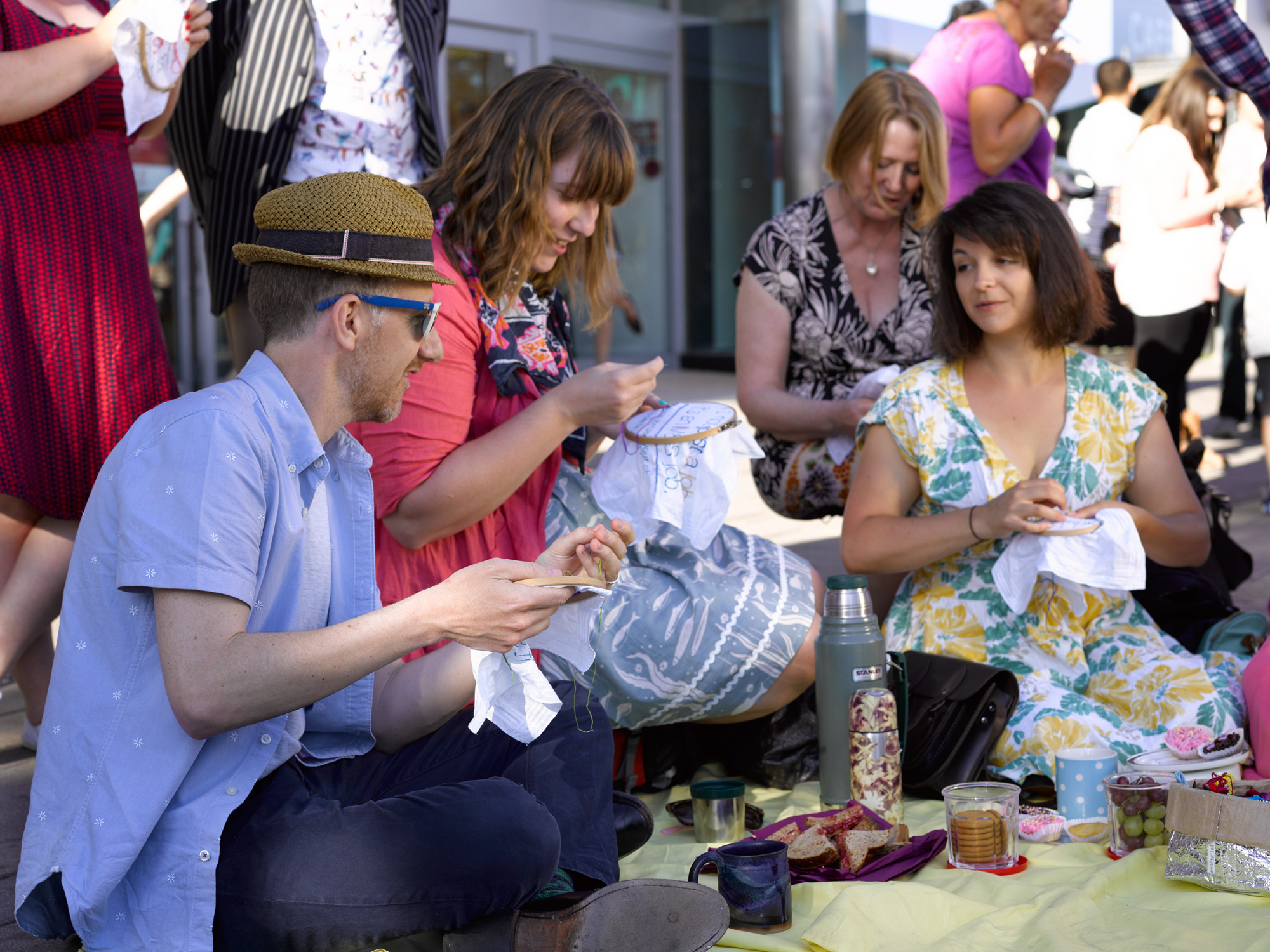
I also encouraged craftivists across the UK to set up a “stitch-in” — my craftivist version of a protest sit-in — outside M&S stores in their area. I asked them to invite less than a dozen people who looked like the company’s customers and to set up colorful, friendly and inviting picnics near the store entrance. Craftivists were encouraged to offer food and tea to passers-by. The purpose of the stitch-ins was to invite customers and staff to ask us what we were doing, and to show staff that we valued them and wanted to support them by campaigning for a Living Wage.
We knew 1,000 shareholders would be attending the AGM along with many journalists, and we also wanted to make them aware of our campaign. We made 250 kits to give out to them. Each kit had info on the campaign and how they could support it, as well as a needle, thread and a white hankie that was printed in a local independent shop and read: “Please don’t blow your chance to pay the Living Wage”.
On July 7, 2015, 14 craftivists attended the AGM — one of us for each board member. We arrived at 9:30 AM to hand out the kits and greeted shareholders with a simple “Enjoy the AGM.” The company and their security team didn’t mind us giving out our gifts quietly. It was a good start to the day.
Then we had some conflict. A staff member came to take our 14 handkerchief boxes and said she’d deliver them to the board. We wanted to hand them over ourselves, but she said this would not be possible. After negotiating, she agreed to take half and let us hand over the other half at meeting’s end.
The room was a large conference hall, and at the front was a long table with 14 chairs facing the audience. The board members walked in and took those seats. The chairman of the board stood up to give his introduction, and to our surprise, he mentioned our campaign, calling it “a test case for how these campaigns should be run.” But we couldn’t tell if that meant we’d get the meeting we wanted.
After a summary of the company’s year and its future plans, it was time for shareholder questions. Caroline, who’d made a hanky for a board member and is a trustee of ShareAction, asked the board to update shareholders on what deliberations had been made on the UK Living Wage. The CEO reminded us of the company’s competitive rewards for their staff, implying that they should be enough. He said he believed that M&S treated its workers fairly.
Then I was ushered up to ask my question. (Some of us had bought a share in the company before the event so we could stand with the shareholders.) With a deep breath and my heart racing, I said:
Good morning. I’m Sarah Corbett and I’m a shareholder. I’ve spent the last few weeks working with fellow craftivists around the country on a project that we hope will be life-changing. We are super-excited about this AGM and giving each of you our handcrafted bespoke gifts to encourage you to make positive life-changing decisions in your roles as board members. Our gifts to you have taken in total over a hundred hours to stitch. Over the last few weeks we’ve had lots of fun stitching, chatting and engaging customers, staff and passers-by at your stores.
What we’ve learnt is that people love your company but they expect a lot from you. They were very surprised you do not pay the Living Wage and are keen that you do become a Living Wage Employer in the near future. So here they are, our gifts [at this point, all the craftivists stood and held them up above their heads for all to see]. We hope you treasure their timeless messages. It would mean a lot to us if you made the time to meet the makers of your gifts at the end of the AGM today, please, and agree to a meeting with ShareAction to discuss the Living Wage in more detail. Thank you.
The audience clapped, and the chair thanked us for his hanky. He must have received his from the staff member — what seemed like a crack in our plan turned out to be a benefit! (His hanky featured a quote by the Dalai Lama that read: “Open our arms to change, but don’t let go of your values.”) He told the audience, “It’s a campaign that is thoughtfully done and heartfelt. We feel every bit as heartfelt about our employees. Do meet us at the side of the stage here at the end to drop off your gifts.”
When the AGM finished, our 14 craftivists walked over to talk to the board members. I’d briefed them to notice their member’s tone of voice, watch their body language, listen to their responses, and then email me afterwards so we could figure out who’d be a useful ally and who might try to block our goal.
When I chatted with my recipient, she said she’d do what she could before she left the board in nine months’ time. She gave me her email and asked me to keep her updated. She also told me the board had been looking at the seven gifts and letters, and they had debated who had the best hanky. She said they were all talking about the campaign and Living Wage even before they walked out onto the stage.
Some board members were less open and less warm, and one was guarded and not keen to discuss the Living Wage. Still, this was all useful intelligence for the campaign. Before we left, a staff member told me that a meeting would be set up with us and M&S’s Director of Sustainable Business to discuss this issue more.
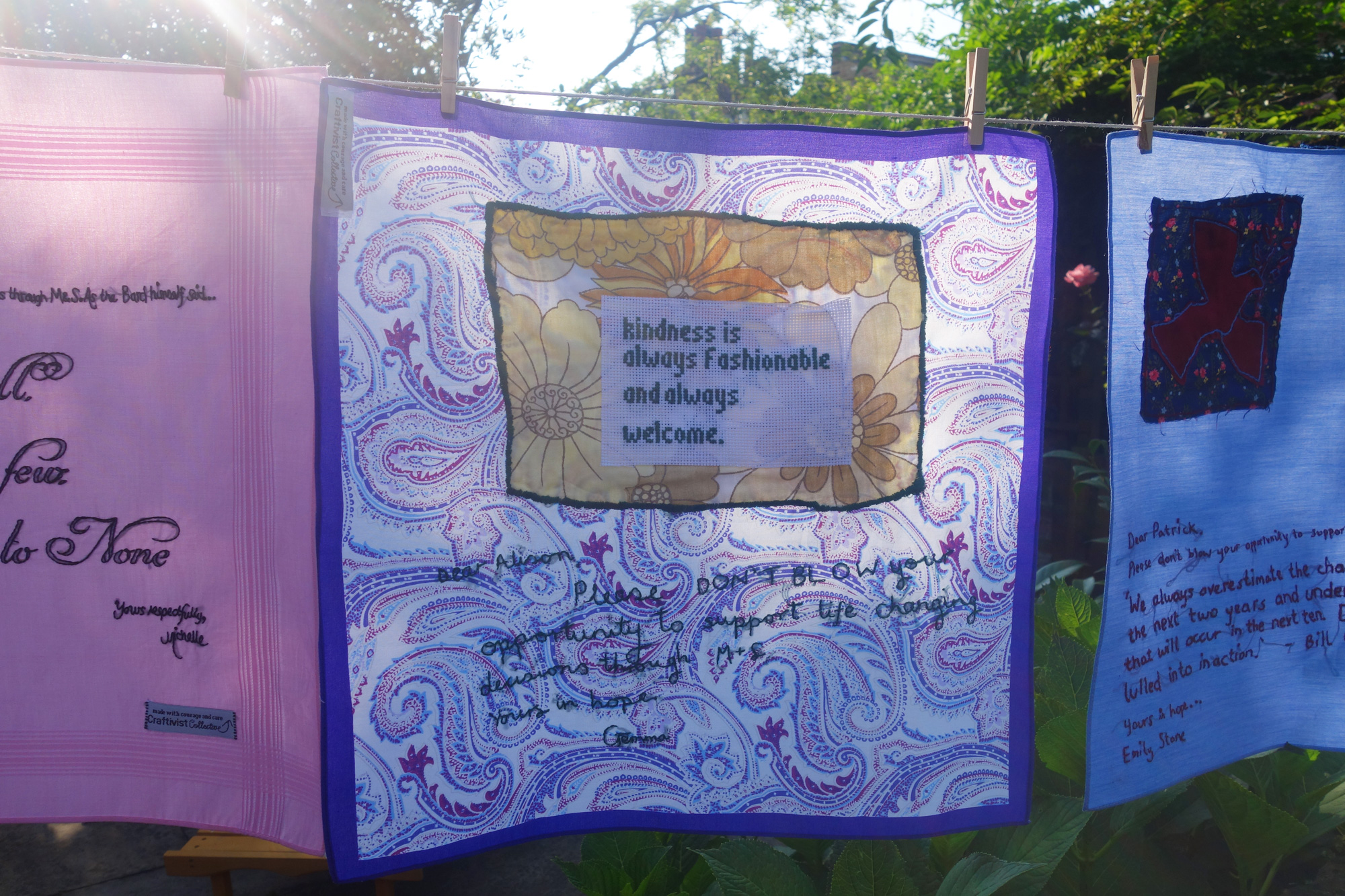
But work wasn’t over for us. Our meeting with the head of Sustainability didn’t happen until January 2016, eight months after the AGM. Before it, we handmade holiday cards for all our hanky-receivers to remind them that “all we want for Christmas is for the company to pay the Living Wage” and to be a shining light for the rest of the retail sector in terms of values.
When the meeting came, we felt like we were in a strong position. The government’s budget announcement in July 2015 of a “national living wage” spotlighted the need for fair pay and the salary problems in the retail sector. We were reassured that the company recognized the business benefits of treating people fairly, and we heard they’d been considering the issue at the highest level. We were also told their new CEO (who’d been a board member and so had gotten a hankie) would start his post in April 2016 and hoped to make real progress on this.
In our meeting, we heard from the head of Sustainability that M&S was determined to be a workplace leader, and he was open to the fact that the Living Wage could be a key element. However, we wanted clear evidence that the company was investigating adoption of the Living Wage. We asked that the HR director be at our next meeting, since she would be the person to implement the living wage.
In April 2016, UK craftivists sent the new CEO cards congratulating him on his new role and encouraging him to implement the Living Wage. He’d risen up the ranks from the shop floor, a huge achievement for anyone and a possible benefit for our campaign, which affects the people who worked where he’d come from. Soon after, we heard from a ShareAction trustee. She’d seen the chair of the board at an event. The chair and his wife said our handkerchiefs had had a profound impact on the entire board, and the Living Wage wouldn’t have been on their agenda without our gentle protest. He introduced the trustee to CEO, who said he was grateful for our campaign and wanted to write to each of the craftivists to thank them (which he did).
Then, in May 2016, M&S made an announcement. They were going to pay above the current Living Wage rates — 50,000 employees had their pay increased! But they didn’t say that they were committed to accreditation, which meant they could fall below paying the independent living wage in future years.
So, two months later, 14 craftivists and I went back to the M&S annual general meeting. Since we didn’t want to dilute our hankie campaign, we gave out handmade cards with jigsaw-puzzle imagery – symbolizing that accreditation was the last piece needed for the Living-Wage puzzle and that board members had the power to complete it. With each card, we also gave handcrafted key rings in colors and patterns that matched their hankies.
This time, we received a much warmer welcome, and the board members spoke to us for longer periods at the end of the meeting. Seeing them in person again strengthened our relationship with them and showed our commitment. Listening to their arguments for and against the Living Wage helped strengthen our campaign.
As with most efforts like this, the process is slow but we are making progress, and we’re proud that our hankies played a role. At this time, ShareAction, the Craftivist Collective and the Living Wage Foundation are still working hard to help convince M&S to take the next step and become accredited Living Wage Employers.
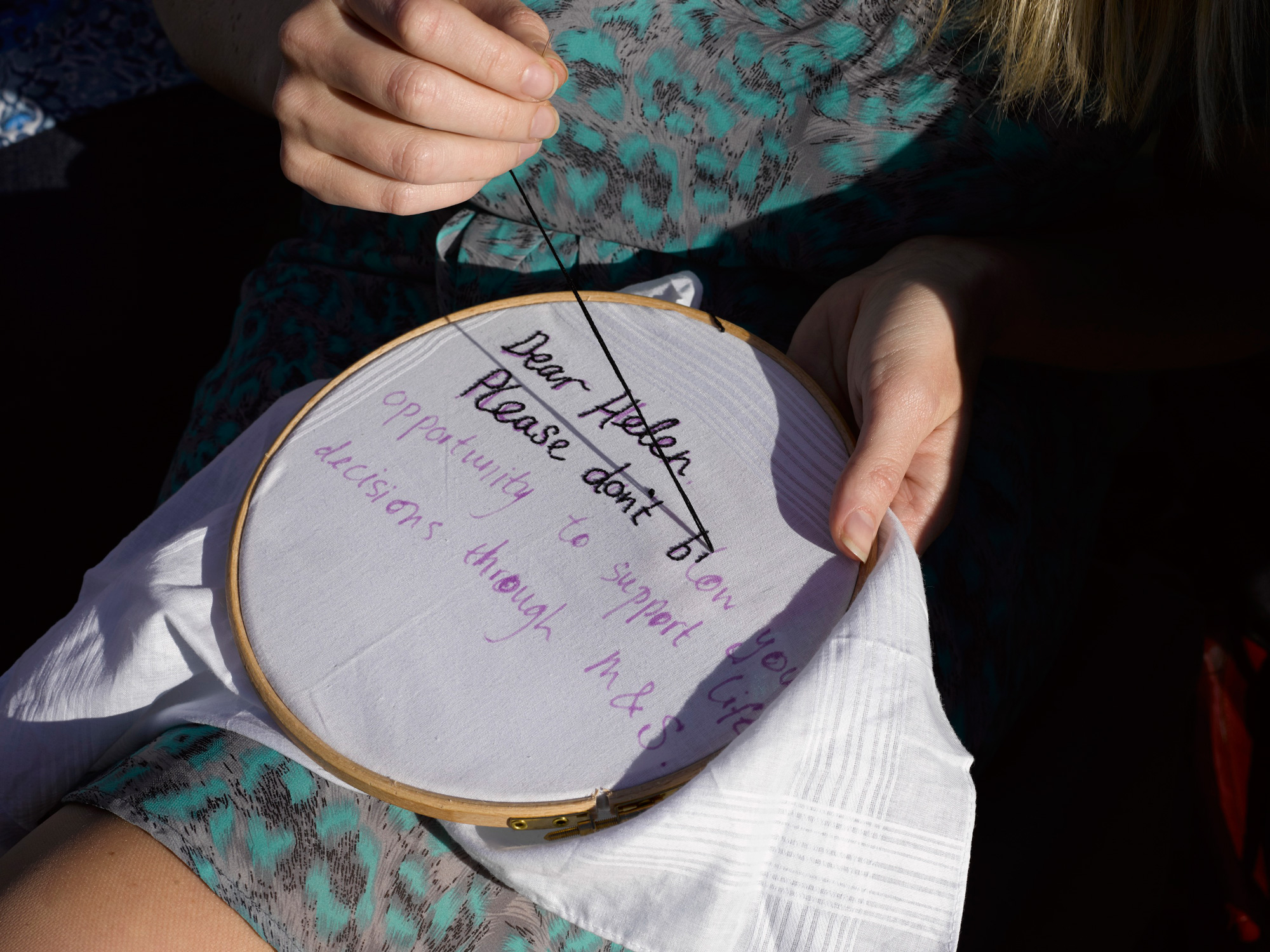
But while our hankies definitely opened the doors to a meeting with company officials, there is so much more to craftivism than embroidering handkerchiefs. As craftivists, we need to be crafty in many other ways.
Here are five important elements of our campaigns — and ones to keep in mind when you’re planning your own protest.
1. Ownership. Our messaging and our interactions with the recipients focused on encouraging them to implement changes to their salary policy. But we made it clear that they were the ones to carry out and enforce the changes; we couldn’t. If recipients have ownership of the suggestion, changes are more likely to happen.
2. Empathy. At the AGM, each craftivist made a point of saying clearly to their board member that they understood the pressures they experienced in their role and that what we were asking for wasn’t easy but that we believed in them. This small statement and acknowledgment created allies with most of the people on the board.
3. Allies. Allies in companies or governments are necessary if we’d like long-term changes to be made. We spent our time nurturing friendly contacts, and we looked for other allies when we were faced with blockers.
4. Commitment. We showed our commitment not just in making the gift but in the less fun parts of the campaign. The Director of Sustainability asked me at the AGM in 2016 what company I was going to target next year. I made it clear to him that his company was our only target at the moment, and we weren’t giving up. Not only did it show our determination, but it showed that our priority was accreditation and not our love of sewing or publicity.
5. Ripples. There are often hidden or unplanned effects of a campaign. At the second AGM, we heard from board members, their colleagues and their partners about how our hankies had affected them personally, whether it created conversations at home with their families about the Living Wage or it resulted in the wife of a board member wanting to join our craftivist collective.
All images are from Polly Braden for Craftivist Collective.
Excerpted with permission from the book How to Be a Craftivist: The Art of Gentle Protest by Sarah Corbett. Published by Unbound, an imprint of HarperCollins Publishers. © 2017 Sarah Corbett.
Watch her TEDxYouth@Bath talk here:















